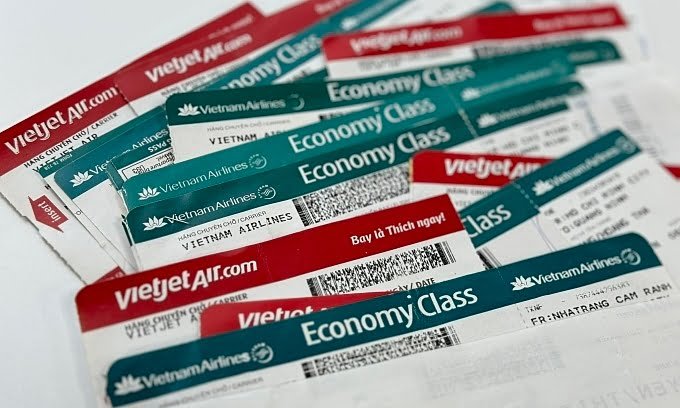These fares usually climb to a peak during the two or three weeks around the Tet (Lunar New Year) holidays, which this year lasted from February 7 to 14, when people travel to their hometown, before gradually decreasing.
Yet now, two weeks after the holidays, the fares have barely declined, Ngoc Tuan, the owner of a flight booking agency in Hanoi, said.
Last week, most flights from Hanoi, Hai Phong City, Thanh Hoa City to Ho Chi Minh City were fully booked by Thursday.
For the Hanoi-HCMC route, only business class tickets at VND7 million (US$283.9) were available for Mar. 1.
Ngoc Ha of Hanoi’s Nam Tu Liem District had to put off a trip to HCMC until next week due to the excessively high fares.
Even then her ticket is only VND1 million cheaper.
One reason for the exorbitant fares is an aircraft shortage.
Due to issues related to the Pratt & Whitney engines used in the A321, the main aircraft used on domestic routes, Vietnam Airlines recently grounded 12 planes, or about 20% of its narrow-body fleet.
Vietjet Air is also affected by the engine issue, but has not disclosed details.
Bamboo Airways, embattled and going through a major restructuring, only has eight planes, less than half the 20 it had a year ago.
Pacific Airlines also downsized its fleet recently.
For Tet, Vietnam Airlines, Vietjet and Bamboo Airways had to wet lease (hiring aircraft and at least one crew member) a combined 12 planes but were still unable to cope with demand.
Domestic schedules have also been pared since airlines are switching their focus to international routes.
Since the last quarter of 2023 some airlines have been reducing the frequency of services on low-demand routes or even canceling them to switch to international services, demand for which is growing.
International flights are also more profitable than domestic ones because airlines can collect fuel surcharges on fares.
For example, a fuel surcharge of over VND1.1 million is allowed for Hanoi-Tokyo flights.
An international flight can be five to seven times more profitable than a domestic one, excluding the lucrative Hanoi-HCMC route, according to the director of an airport, who asked not to be identified.
An airline said it is having difficulty managing its fleet to balance between popular domestic routes such as from Hanoi and HCMC to destinations like Nha Trang and Quy Nhon and charter flights serving international tourists.
Rising costs have also been driving up airfares in recent years, according to an official at a domestic airline.
Fuel costs have nearly doubled from 25% of the fare pre-Covid to nearly 40% now, he said.
Furthermore, airlines pay for most of their expenses in dollars, which has appreciated sharply against the dong meaning they have to pay more now.
The global supply chain disruption and aircraft shortage have resulted in more expensive plane leases, he added.
Thus, though airlines want to boost their capacity, their financial constraints prevent that, he added.
According to the owner of a ticketing office in Hanoi, the scarcity of tickets on some popular domestic routes could also be due to some booking agents hoarding them to sell at high prices.
He recounted how a few weeks ago the Hanoi-HCMC route had been sold out but some agents still had them listed as available for VND5 million.
Based on airlines’ capacity, the aviation authorities have forecast that airports will see 3.5 million fewer domestic passengers this year.
The number of international passengers could increase by more than 30% to 41.8 million, they added.
At an aviation seminar on February 28, Vietnam Airlines CEO Le Hong Ha said airfares would remain high this year though his airline would strive to offer promotions for the summer season.
Starting on March 1 the fare caps for most domestic routes have increased by about 5%.
Trips over 1,280 kilometers, such as the Hanoi-Phu Quoc route, saw the biggest increase of VND250,000 to VND4 million.
This could further cause domestic airfares to rise during peak seasons.



